
3.5.2 Physics Paper 2 (232/2)
SECTION A (25 marks)
Answer all the questions in this section in the spaces provided.
1. Figure 1 shows two parallel rays from a distant object passing through a convex lens:

(a) Indicate on the diagram, the position of the principal focus of the lens. (1 mark)
(b) Determine the focal length of the lens. (1 mark)
2. State the effect of decreasing the distance between the plates of a parallel plate capacitor on the capacitance. (1 mark)
3. Figure 2 shows circular waves originating from the principal focus F of a concave mirror and moving towards the mirror.

Complete the diagram to show the reflected waves. (1 mark)
4. The frequency of an electromagnetic wave is 4.0 >< l0“ Hz. Determine its wavelength. (take speed oflighz as 3.0 >< I08ms” ). (3 marks)
5. Figure 3 shows a nail on which a wire is to be wound to make an electromagnet.

By drawing, show how the wire should be wound around the nail so that end A becomes a north pole and end B a south pole. (1 mark)
6. It is observed that when the cap of an uncharged electroscope is irradiated with light of high frequency, the leaf of the electroscope rises. Explain this observation. (3 marks)
7. Figure 4 shows the magnetic field pattern around two bar magnets placed side by side.

Indicate on the diagram the poles of each magnet. (1 mark)
8. Figure 5 shows a graph of current against voltage for a semiconductor diode.
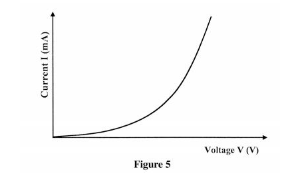
In the space provided, draw a circuit diagram that may be used to obtain values needed to draw the graph in figure 5. (3 marks)
9. Radium undergoes radioactive decay by emitting an alpha particle to form a daughter nuclide Q as in the reaction:

Determine the values of:
(a) x …………………………………….. .. (1 mark)
(b) y …………………………………….. .. (1 mark)
10. State two uses of a charged gold leaf electroscope. (2 marks)
11. The anode of an x-ray tube becomes hot when the tube is in use. State the reason for this. (1 mark)
12. Draw a ray diagram to show how a ray of light may be totally internally reflected two times in an isosceles right – angled glass prism. (Assume that the critical angle of glass is 42”) (2 marks)
13. The current of electrons hitting the screen of a cathode ray oscilloscope is 2.0 X 10 “ A .
Determine the number of electrons that strike the screen each second. (take charge qfun electron as 1.6 >< 107” C). (3 marks)
SECTION B (55 marks)
Answer all the questions in this section in the spaces provided.
14 (a) Figure 6 shows a simple electric bell circuit.

(i) Name the parts labelled:
(I) D(1 mark)
(II) E(1 mark)
(ii) When the switch is closed, the hammer hits the gong repeatedly. Explain why:
(I) the hammer hits the gong.(2 marks)
(II) the hammer hits the gong repeatedly. (3 marks)
(b) An electric bulb is rated 60 W, 240 V. Determine:
(i) the current that flows through it when it is connected to a 240 V supply.(3 marks)
(ii) the resistance of the bulb.(3 marks)
15 (a) One of the causes of energy loss in a transformer is heating in the coils when current flows. State:
(i) the reason Why the current causes heating. (1 mark)
(ii) how the heating can be minimized. (1 mark)
The input voltage of a transformer is 240 V and its output is l2 V. When an 80 W bulb is connected across the secondary coil, the current in the primary coil is 0.36 A. Determine:
(i) the ratio
of the transformer, (where Np is the number of turns in the primary coil and Ns is the number of turns in the secondary coil) (3 marks)
(ii) the power input of the transformer. (3 marks)
(iii) the power output of the transformer. (1 mark)
(iv) the efficiency of the transformer. (2 marks)
16. Figure 7 shows resistors R I and R2 connected in parallel. Their ends are connected to a battery of potential difference V volts.
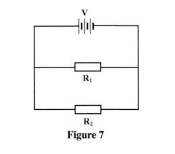
(i) In terms of V1, RI and R2, write an expression for:
(I) current l1 through R1. (1 mark)
(II) current I2 through R2; (1 mark)
(III) total current l in the circuit. (1 mark)
(ii) Show that the total resistance

(3 marks)
(b) Figure 8 shows a negatively charged rod placed near an uncharged conductor resting on an insulating support.
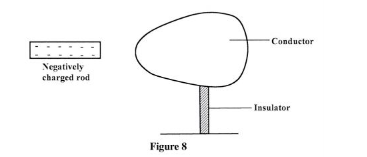
(i) Show the charge distribution on the conductor. (2 marks)
(ii) State the effect:
(i) of momentarily touching the conductor with a finger while the charged rod is still near the conductor. (1 mark)
(ii) on the charge distribution of withdrawing the negatively charged rod after momentarily touching the conductor. (1 mark)
(iii) In the space provided, sketch a diagram to show how the charge in ii (II) would have been distributed if the conductor was a sphere. (1 mark)
17. (a)Figure 9 shows two speakers S1 and S2 which produce sound of the same frequency. They are placed equidistant from a line AB and a line PQ. (PQ is perpendicular to line AB).
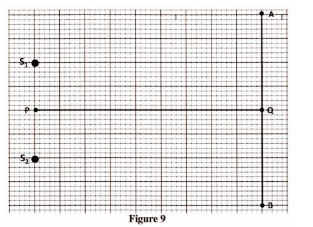
(i) A student walking from A to B hears alternating loud and soft sounds. Explain why at some point the sound heard is soft. (2 marks)
(ii) The student now Walks along line PQ. State with reason the nature of the sound the student hears. (3 marks)
(b) Figure 10 shows sound waves in air produced by a vibrating tuning fork. R is an air molecule on the path of the waves.
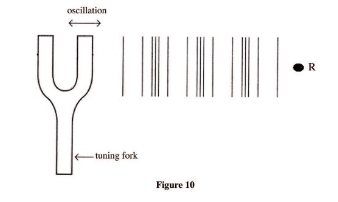
(i) Using a line, indicate on the diagram a distance d equal to one wavelength of the wave. (1 mark)
(ii) In the space provided, show with an arrow the direction of motion of the air molecule R as the waves pass. (1 mark)
(iii) Explain the reason for the answer in (ii). (2 marks)
18 Figure 11 shows an object placed 10 cm in front of a concave mirror whose radius of curvature is 40 cm.
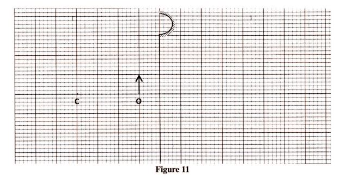
(a) (i) On the same figure, draw a ray diagram to show the position of the image formed. (3 marks)
(ii) Use the ray diagram to determine:
(I) the image distance. (1 mark)
(II) the magnification. (3 marks)
(in) State where the position of the image would be if the object had been placed at the principal focus. (1 mark)
(b) Draw a ray diagram to show the formation of a partially dark shadow and a totally dark shadow during the eclipse of the sun. (3 marks)
